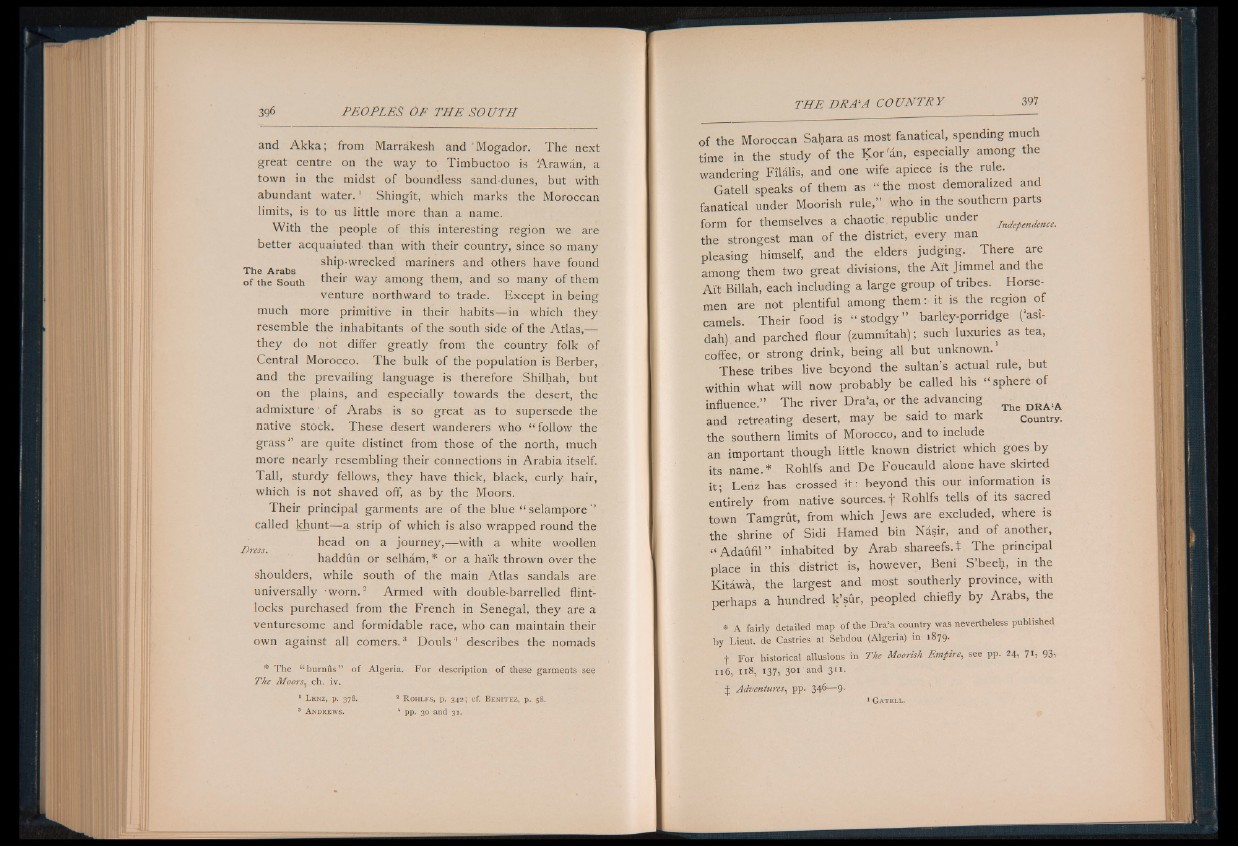
396 PEOPLES OF THE SOUTH
and Akka; from Marrakesh and 'Mogador. The next
great centre on the way to Timbuctoo is Arawan, a
town 111 the midst of boundless sand-dunes, but with
abundant water.1 Shingit, which marks the Moroccan
limits, is to us little more than a name.
With the people of this interesting region we are
better acquainted- than with their country, since so many
ship-wrecked mariners and others have found
T'hc Arabs
of the South their way among them, and so many of them
venture northward to trade. Except in being
much more primitive in their habits— in which they
resemble the inhabitants of the south side of the Atlas,—
they do not differ greatly from the country folk of
Central Morocco. The bulk of the population is Berber,
and the prevailing language is therefore Shilhah, but
on the plains, and especially towards the desert, the
admixture' of Arabs is so great as to supersede the
native stock. These desert wanderers who “ follow the
grass'’ are quite distinct from those of the north, much
more nearly resembling their connections in Arabia itself.
Tall, sturdy fellows, they have thick, black, curly hair,
which is not shaved off, as by the Moors.
Their principal garments are of the blue “ selampore’’
called khunt— a strip of which is also wrapped round the
head on a journey,— with a white woollen
Dress. '
haddun or selham, * or a haik thrown over the
shoulders, while south of the main Atlas sandals are
universally worn.2 Armed with double-barrelled flintlocks
purchased from the French in Senegal, they are a
venturesome and formidable race, who can maintain their
own against all comers.3 Douls4 describes the nomads
* The “ burnus” of Algeria. For description of these garments see
The Moors. ch. iv.
1 L e n z , p. 378. 2 R o h l f s , p . 3 4 2 ; c f . B e n i t e z , p . 58.
3 A n d r ew s . 4 p p . 30 an d 31.
of the Moroccan Sahara as most fanatical, spending much
time in the study of the Kor'an, especially among the
wandering Fildlis, and one wife apiece is the rule.
Gatell speaks of them as “ the most demoralized and
fanatical under Moorish rule,” who in the southern parts
form for themselves a chaotic republic under Indepeniience.
the strongest man of the district, every man
pleasing himself, and the elders judging. There are
among them two great divisions, the Ait Jimmel and the
A it Billah, each including a large group of tribes. Horsemen
are not plentiful among them: it is the region of
camels. Their food is “ stodgy ” barley-porridge (‘asi-
dah) and parched flour (zummitah); such luxuries as tea,
coffee, or strong drink, being all but unknown.
These tribes live beyond the sultan’s actual rule, but
within what will now probably be called his “ sphere of
influence.” The river Dra’a, or the advancing d r a * a
and retreating desert, may be said to mark country,
the southern limits of Morocco, and to include
an important though little known district which goes by
its name.* Rohlfs and De Foucauld alone have skirted
it; Lenz has crossed it: beyond this our information is
entirely from native sources, f Rohlfs tells of its sacred
town Tamgrut, from which Jews are excluded, where is
the shrine of Sidi Hamed bin Nasir, and of another,
“ Adaufil” inhabited by Arab shareefs.t The principal
place in this district is, however, Beni S ’beeh, in the
Kitawa, the largest and most southerly province, with
perhaps a hundred k ’sur, peopled chiefly by Arabs, the
* A fairly detailed map of the Dra’a country was nevertheless published
by Lieut, de Castries at Sebdou (Algeria) in 1879.
| For historical allusions in The Moorish Empire, see pp. 24, 71, 93,
116, 118, 137, 301 and 311.
J Adventures, pp. 346— 9-